HRMT20024 T2 2018 Assessment 2 – Annotated Bibliography Report
VerifiedAdded on 2023/06/08
|5
|2503
|94
Report
AI Summary
This annotated bibliography examines five articles related to human resource management (HRM) practices within the hospitality sector. The introduction highlights the focus on HR planning, recruitment, and the strategic fit between employers and employees, including the role of social media. The first article analyzes HRM practices in the hospitality and healthcare sectors, discussing recruitment, training, and performance appraisal. The second article emphasizes sustainable HRM and its impact on tourism policy and planning, highlighting the importance of employee well-being. The third article focuses on online and social media recruitment, exploring its implications for the hospitality sector and the broadening role of recruitment. The fourth article revisits talent management, work-life balance, and retention strategies, and the fifth article discusses employee engagement, HRM practices, and competitive advantage, emphasizing participative leadership. Each article summary includes key ideas, research methodologies, conclusions, and a critique, providing insights into how each article contributes to the understanding of HRM within the hospitality industry.
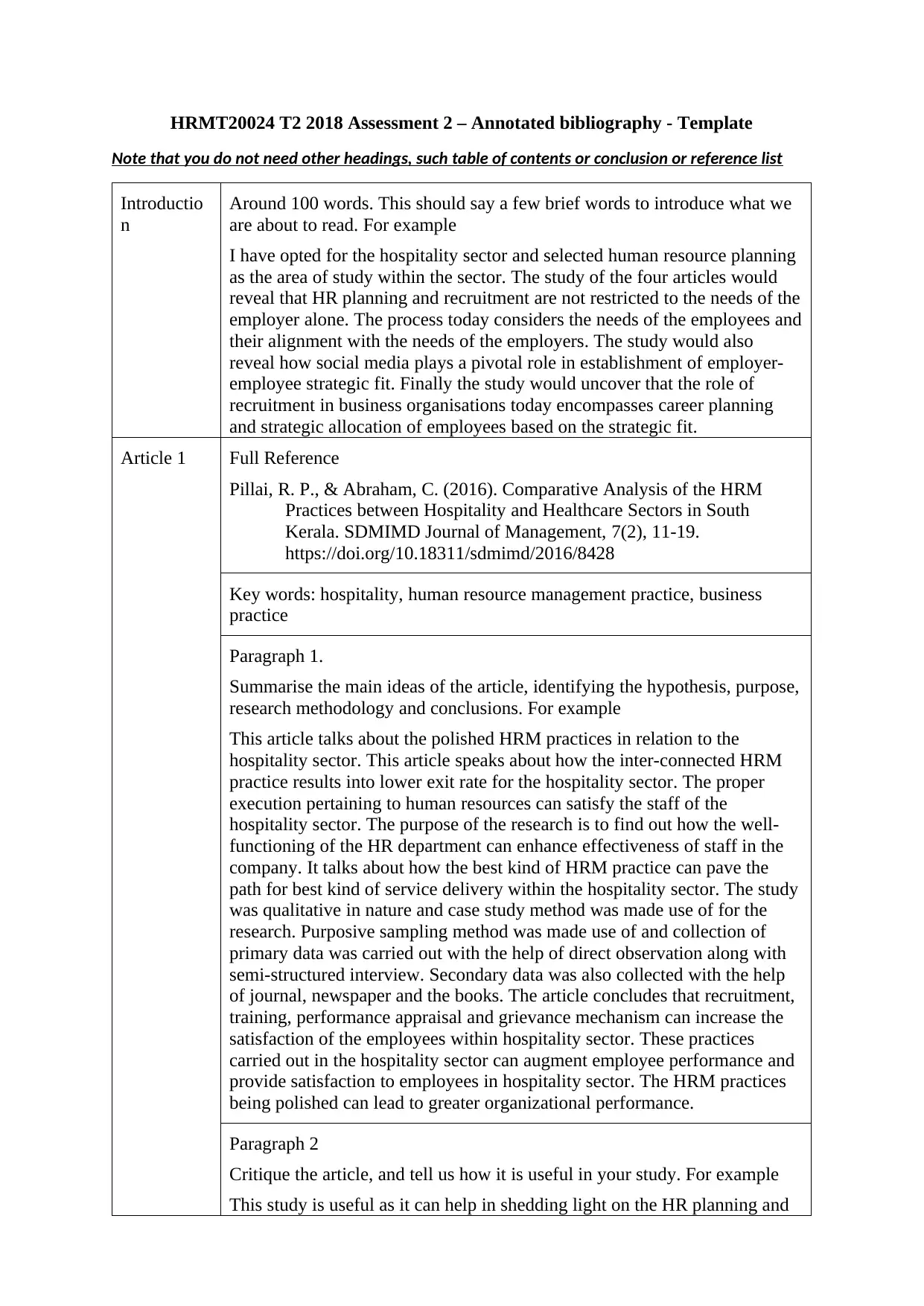
HRMT20024 T2 2018 Assessment 2 – Annotated bibliography - Template
Note that you do not need other headings, such table of contents or conclusion or reference list
Introductio
n
Around 100 words. This should say a few brief words to introduce what we
are about to read. For example
I have opted for the hospitality sector and selected human resource planning
as the area of study within the sector. The study of the four articles would
reveal that HR planning and recruitment are not restricted to the needs of the
employer alone. The process today considers the needs of the employees and
their alignment with the needs of the employers. The study would also
reveal how social media plays a pivotal role in establishment of employer-
employee strategic fit. Finally the study would uncover that the role of
recruitment in business organisations today encompasses career planning
and strategic allocation of employees based on the strategic fit.
Article 1 Full Reference
Pillai, R. P., & Abraham, C. (2016). Comparative Analysis of the HRM
Practices between Hospitality and Healthcare Sectors in South
Kerala. SDMIMD Journal of Management, 7(2), 11-19.
https://doi.org/10.18311/sdmimd/2016/8428
Key words: hospitality, human resource management practice, business
practice
Paragraph 1.
Summarise the main ideas of the article, identifying the hypothesis, purpose,
research methodology and conclusions. For example
This article talks about the polished HRM practices in relation to the
hospitality sector. This article speaks about how the inter-connected HRM
practice results into lower exit rate for the hospitality sector. The proper
execution pertaining to human resources can satisfy the staff of the
hospitality sector. The purpose of the research is to find out how the well-
functioning of the HR department can enhance effectiveness of staff in the
company. It talks about how the best kind of HRM practice can pave the
path for best kind of service delivery within the hospitality sector. The study
was qualitative in nature and case study method was made use of for the
research. Purposive sampling method was made use of and collection of
primary data was carried out with the help of direct observation along with
semi-structured interview. Secondary data was also collected with the help
of journal, newspaper and the books. The article concludes that recruitment,
training, performance appraisal and grievance mechanism can increase the
satisfaction of the employees within hospitality sector. These practices
carried out in the hospitality sector can augment employee performance and
provide satisfaction to employees in hospitality sector. The HRM practices
being polished can lead to greater organizational performance.
Paragraph 2
Critique the article, and tell us how it is useful in your study. For example
This study is useful as it can help in shedding light on the HR planning and
Note that you do not need other headings, such table of contents or conclusion or reference list
Introductio
n
Around 100 words. This should say a few brief words to introduce what we
are about to read. For example
I have opted for the hospitality sector and selected human resource planning
as the area of study within the sector. The study of the four articles would
reveal that HR planning and recruitment are not restricted to the needs of the
employer alone. The process today considers the needs of the employees and
their alignment with the needs of the employers. The study would also
reveal how social media plays a pivotal role in establishment of employer-
employee strategic fit. Finally the study would uncover that the role of
recruitment in business organisations today encompasses career planning
and strategic allocation of employees based on the strategic fit.
Article 1 Full Reference
Pillai, R. P., & Abraham, C. (2016). Comparative Analysis of the HRM
Practices between Hospitality and Healthcare Sectors in South
Kerala. SDMIMD Journal of Management, 7(2), 11-19.
https://doi.org/10.18311/sdmimd/2016/8428
Key words: hospitality, human resource management practice, business
practice
Paragraph 1.
Summarise the main ideas of the article, identifying the hypothesis, purpose,
research methodology and conclusions. For example
This article talks about the polished HRM practices in relation to the
hospitality sector. This article speaks about how the inter-connected HRM
practice results into lower exit rate for the hospitality sector. The proper
execution pertaining to human resources can satisfy the staff of the
hospitality sector. The purpose of the research is to find out how the well-
functioning of the HR department can enhance effectiveness of staff in the
company. It talks about how the best kind of HRM practice can pave the
path for best kind of service delivery within the hospitality sector. The study
was qualitative in nature and case study method was made use of for the
research. Purposive sampling method was made use of and collection of
primary data was carried out with the help of direct observation along with
semi-structured interview. Secondary data was also collected with the help
of journal, newspaper and the books. The article concludes that recruitment,
training, performance appraisal and grievance mechanism can increase the
satisfaction of the employees within hospitality sector. These practices
carried out in the hospitality sector can augment employee performance and
provide satisfaction to employees in hospitality sector. The HRM practices
being polished can lead to greater organizational performance.
Paragraph 2
Critique the article, and tell us how it is useful in your study. For example
This study is useful as it can help in shedding light on the HR planning and
Paraphrase This Document
Need a fresh take? Get an instant paraphrase of this document with our AI Paraphraser
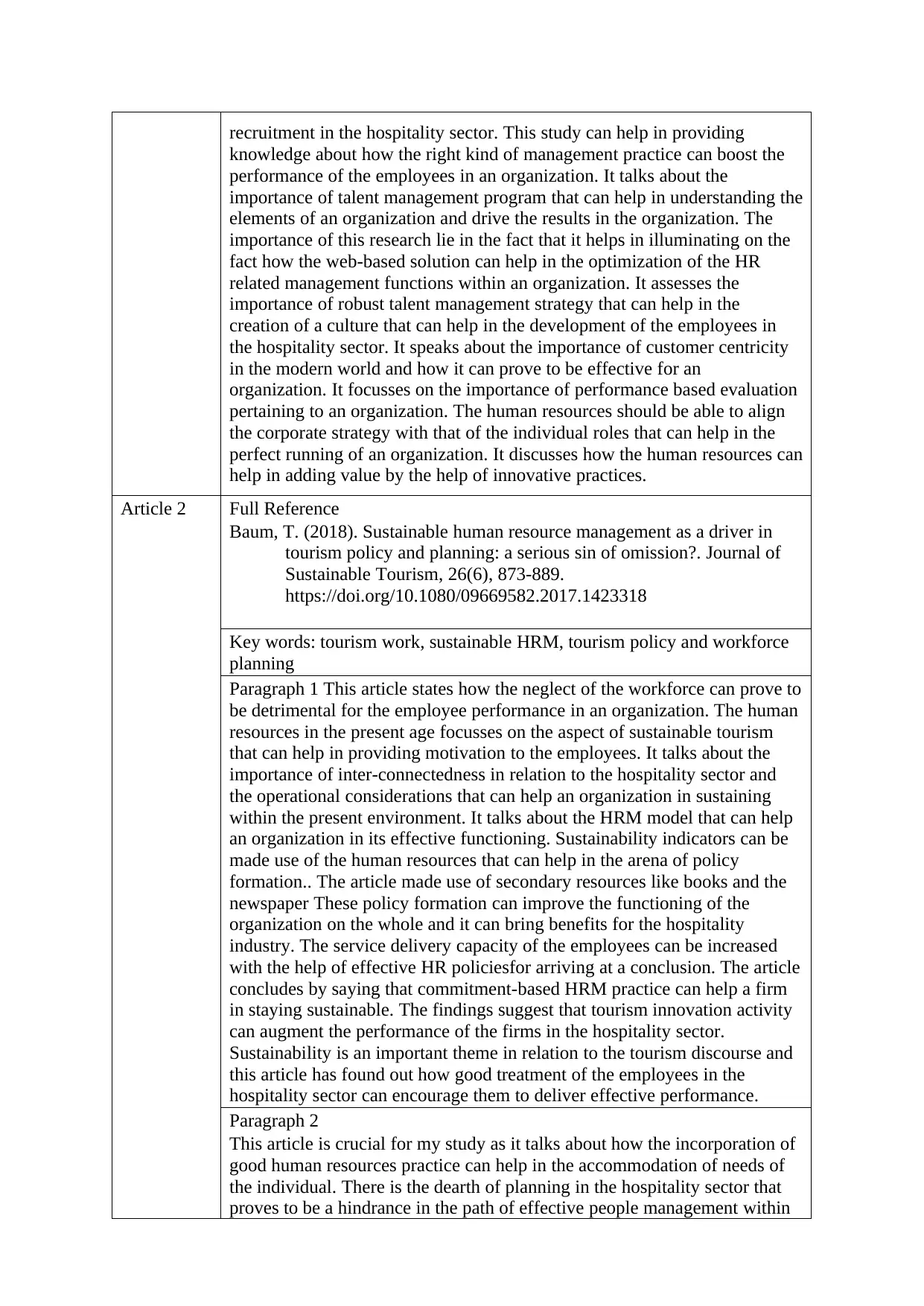
recruitment in the hospitality sector. This study can help in providing
knowledge about how the right kind of management practice can boost the
performance of the employees in an organization. It talks about the
importance of talent management program that can help in understanding the
elements of an organization and drive the results in the organization. The
importance of this research lie in the fact that it helps in illuminating on the
fact how the web-based solution can help in the optimization of the HR
related management functions within an organization. It assesses the
importance of robust talent management strategy that can help in the
creation of a culture that can help in the development of the employees in
the hospitality sector. It speaks about the importance of customer centricity
in the modern world and how it can prove to be effective for an
organization. It focusses on the importance of performance based evaluation
pertaining to an organization. The human resources should be able to align
the corporate strategy with that of the individual roles that can help in the
perfect running of an organization. It discusses how the human resources can
help in adding value by the help of innovative practices.
Article 2 Full Reference
Baum, T. (2018). Sustainable human resource management as a driver in
tourism policy and planning: a serious sin of omission?. Journal of
Sustainable Tourism, 26(6), 873-889.
https://doi.org/10.1080/09669582.2017.1423318
Key words: tourism work, sustainable HRM, tourism policy and workforce
planning
Paragraph 1 This article states how the neglect of the workforce can prove to
be detrimental for the employee performance in an organization. The human
resources in the present age focusses on the aspect of sustainable tourism
that can help in providing motivation to the employees. It talks about the
importance of inter-connectedness in relation to the hospitality sector and
the operational considerations that can help an organization in sustaining
within the present environment. It talks about the HRM model that can help
an organization in its effective functioning. Sustainability indicators can be
made use of the human resources that can help in the arena of policy
formation.. The article made use of secondary resources like books and the
newspaper These policy formation can improve the functioning of the
organization on the whole and it can bring benefits for the hospitality
industry. The service delivery capacity of the employees can be increased
with the help of effective HR policiesfor arriving at a conclusion. The article
concludes by saying that commitment-based HRM practice can help a firm
in staying sustainable. The findings suggest that tourism innovation activity
can augment the performance of the firms in the hospitality sector.
Sustainability is an important theme in relation to the tourism discourse and
this article has found out how good treatment of the employees in the
hospitality sector can encourage them to deliver effective performance.
Paragraph 2
This article is crucial for my study as it talks about how the incorporation of
good human resources practice can help in the accommodation of needs of
the individual. There is the dearth of planning in the hospitality sector that
proves to be a hindrance in the path of effective people management within
knowledge about how the right kind of management practice can boost the
performance of the employees in an organization. It talks about the
importance of talent management program that can help in understanding the
elements of an organization and drive the results in the organization. The
importance of this research lie in the fact that it helps in illuminating on the
fact how the web-based solution can help in the optimization of the HR
related management functions within an organization. It assesses the
importance of robust talent management strategy that can help in the
creation of a culture that can help in the development of the employees in
the hospitality sector. It speaks about the importance of customer centricity
in the modern world and how it can prove to be effective for an
organization. It focusses on the importance of performance based evaluation
pertaining to an organization. The human resources should be able to align
the corporate strategy with that of the individual roles that can help in the
perfect running of an organization. It discusses how the human resources can
help in adding value by the help of innovative practices.
Article 2 Full Reference
Baum, T. (2018). Sustainable human resource management as a driver in
tourism policy and planning: a serious sin of omission?. Journal of
Sustainable Tourism, 26(6), 873-889.
https://doi.org/10.1080/09669582.2017.1423318
Key words: tourism work, sustainable HRM, tourism policy and workforce
planning
Paragraph 1 This article states how the neglect of the workforce can prove to
be detrimental for the employee performance in an organization. The human
resources in the present age focusses on the aspect of sustainable tourism
that can help in providing motivation to the employees. It talks about the
importance of inter-connectedness in relation to the hospitality sector and
the operational considerations that can help an organization in sustaining
within the present environment. It talks about the HRM model that can help
an organization in its effective functioning. Sustainability indicators can be
made use of the human resources that can help in the arena of policy
formation.. The article made use of secondary resources like books and the
newspaper These policy formation can improve the functioning of the
organization on the whole and it can bring benefits for the hospitality
industry. The service delivery capacity of the employees can be increased
with the help of effective HR policiesfor arriving at a conclusion. The article
concludes by saying that commitment-based HRM practice can help a firm
in staying sustainable. The findings suggest that tourism innovation activity
can augment the performance of the firms in the hospitality sector.
Sustainability is an important theme in relation to the tourism discourse and
this article has found out how good treatment of the employees in the
hospitality sector can encourage them to deliver effective performance.
Paragraph 2
This article is crucial for my study as it talks about how the incorporation of
good human resources practice can help in the accommodation of needs of
the individual. There is the dearth of planning in the hospitality sector that
proves to be a hindrance in the path of effective people management within
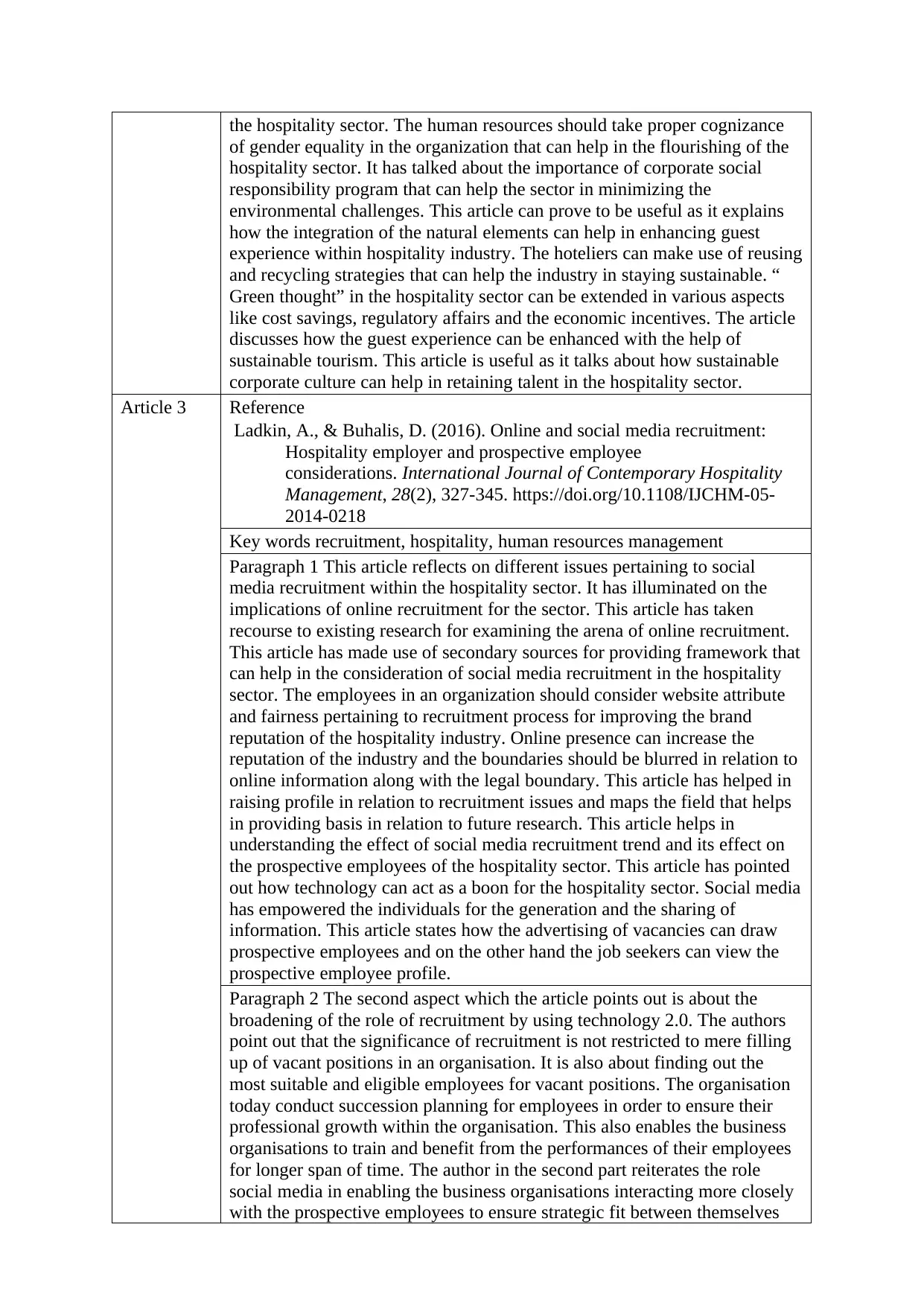
the hospitality sector. The human resources should take proper cognizance
of gender equality in the organization that can help in the flourishing of the
hospitality sector. It has talked about the importance of corporate social
responsibility program that can help the sector in minimizing the
environmental challenges. This article can prove to be useful as it explains
how the integration of the natural elements can help in enhancing guest
experience within hospitality industry. The hoteliers can make use of reusing
and recycling strategies that can help the industry in staying sustainable. “
Green thought” in the hospitality sector can be extended in various aspects
like cost savings, regulatory affairs and the economic incentives. The article
discusses how the guest experience can be enhanced with the help of
sustainable tourism. This article is useful as it talks about how sustainable
corporate culture can help in retaining talent in the hospitality sector.
Article 3 Reference
Ladkin, A., & Buhalis, D. (2016). Online and social media recruitment:
Hospitality employer and prospective employee
considerations. International Journal of Contemporary Hospitality
Management, 28(2), 327-345. https://doi.org/10.1108/IJCHM-05-
2014-0218
Key words recruitment, hospitality, human resources management
Paragraph 1 This article reflects on different issues pertaining to social
media recruitment within the hospitality sector. It has illuminated on the
implications of online recruitment for the sector. This article has taken
recourse to existing research for examining the arena of online recruitment.
This article has made use of secondary sources for providing framework that
can help in the consideration of social media recruitment in the hospitality
sector. The employees in an organization should consider website attribute
and fairness pertaining to recruitment process for improving the brand
reputation of the hospitality industry. Online presence can increase the
reputation of the industry and the boundaries should be blurred in relation to
online information along with the legal boundary. This article has helped in
raising profile in relation to recruitment issues and maps the field that helps
in providing basis in relation to future research. This article helps in
understanding the effect of social media recruitment trend and its effect on
the prospective employees of the hospitality sector. This article has pointed
out how technology can act as a boon for the hospitality sector. Social media
has empowered the individuals for the generation and the sharing of
information. This article states how the advertising of vacancies can draw
prospective employees and on the other hand the job seekers can view the
prospective employee profile.
Paragraph 2 The second aspect which the article points out is about the
broadening of the role of recruitment by using technology 2.0. The authors
point out that the significance of recruitment is not restricted to mere filling
up of vacant positions in an organisation. It is also about finding out the
most suitable and eligible employees for vacant positions. The organisation
today conduct succession planning for employees in order to ensure their
professional growth within the organisation. This also enables the business
organisations to train and benefit from the performances of their employees
for longer span of time. The author in the second part reiterates the role
social media in enabling the business organisations interacting more closely
with the prospective employees to ensure strategic fit between themselves
of gender equality in the organization that can help in the flourishing of the
hospitality sector. It has talked about the importance of corporate social
responsibility program that can help the sector in minimizing the
environmental challenges. This article can prove to be useful as it explains
how the integration of the natural elements can help in enhancing guest
experience within hospitality industry. The hoteliers can make use of reusing
and recycling strategies that can help the industry in staying sustainable. “
Green thought” in the hospitality sector can be extended in various aspects
like cost savings, regulatory affairs and the economic incentives. The article
discusses how the guest experience can be enhanced with the help of
sustainable tourism. This article is useful as it talks about how sustainable
corporate culture can help in retaining talent in the hospitality sector.
Article 3 Reference
Ladkin, A., & Buhalis, D. (2016). Online and social media recruitment:
Hospitality employer and prospective employee
considerations. International Journal of Contemporary Hospitality
Management, 28(2), 327-345. https://doi.org/10.1108/IJCHM-05-
2014-0218
Key words recruitment, hospitality, human resources management
Paragraph 1 This article reflects on different issues pertaining to social
media recruitment within the hospitality sector. It has illuminated on the
implications of online recruitment for the sector. This article has taken
recourse to existing research for examining the arena of online recruitment.
This article has made use of secondary sources for providing framework that
can help in the consideration of social media recruitment in the hospitality
sector. The employees in an organization should consider website attribute
and fairness pertaining to recruitment process for improving the brand
reputation of the hospitality industry. Online presence can increase the
reputation of the industry and the boundaries should be blurred in relation to
online information along with the legal boundary. This article has helped in
raising profile in relation to recruitment issues and maps the field that helps
in providing basis in relation to future research. This article helps in
understanding the effect of social media recruitment trend and its effect on
the prospective employees of the hospitality sector. This article has pointed
out how technology can act as a boon for the hospitality sector. Social media
has empowered the individuals for the generation and the sharing of
information. This article states how the advertising of vacancies can draw
prospective employees and on the other hand the job seekers can view the
prospective employee profile.
Paragraph 2 The second aspect which the article points out is about the
broadening of the role of recruitment by using technology 2.0. The authors
point out that the significance of recruitment is not restricted to mere filling
up of vacant positions in an organisation. It is also about finding out the
most suitable and eligible employees for vacant positions. The organisation
today conduct succession planning for employees in order to ensure their
professional growth within the organisation. This also enables the business
organisations to train and benefit from the performances of their employees
for longer span of time. The author in the second part reiterates the role
social media in enabling the business organisations interacting more closely
with the prospective employees to ensure strategic fit between themselves
⊘ This is a preview!⊘
Do you want full access?
Subscribe today to unlock all pages.

Trusted by 1+ million students worldwide
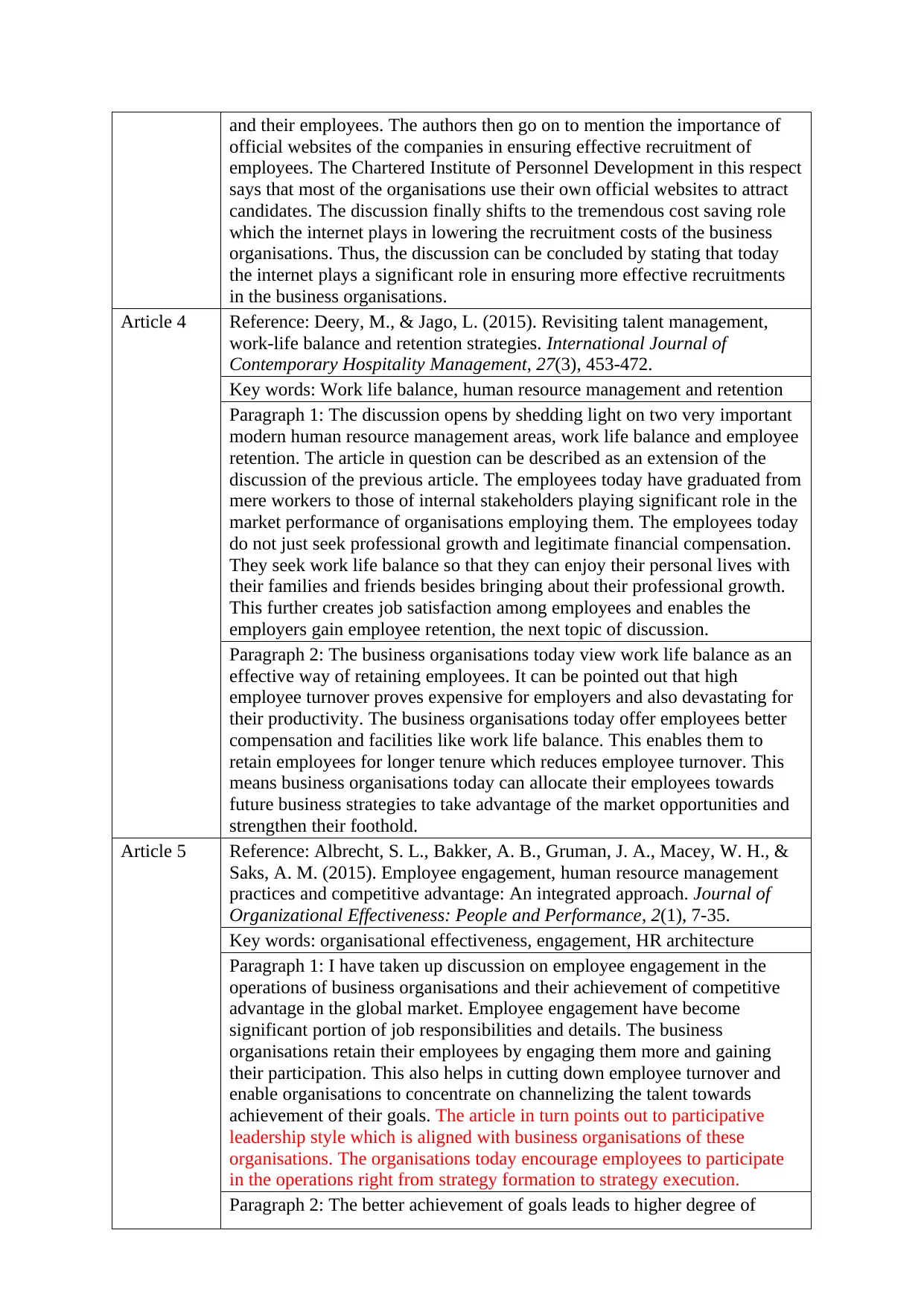
and their employees. The authors then go on to mention the importance of
official websites of the companies in ensuring effective recruitment of
employees. The Chartered Institute of Personnel Development in this respect
says that most of the organisations use their own official websites to attract
candidates. The discussion finally shifts to the tremendous cost saving role
which the internet plays in lowering the recruitment costs of the business
organisations. Thus, the discussion can be concluded by stating that today
the internet plays a significant role in ensuring more effective recruitments
in the business organisations.
Article 4 Reference: Deery, M., & Jago, L. (2015). Revisiting talent management,
work-life balance and retention strategies. International Journal of
Contemporary Hospitality Management, 27(3), 453-472.
Key words: Work life balance, human resource management and retention
Paragraph 1: The discussion opens by shedding light on two very important
modern human resource management areas, work life balance and employee
retention. The article in question can be described as an extension of the
discussion of the previous article. The employees today have graduated from
mere workers to those of internal stakeholders playing significant role in the
market performance of organisations employing them. The employees today
do not just seek professional growth and legitimate financial compensation.
They seek work life balance so that they can enjoy their personal lives with
their families and friends besides bringing about their professional growth.
This further creates job satisfaction among employees and enables the
employers gain employee retention, the next topic of discussion.
Paragraph 2: The business organisations today view work life balance as an
effective way of retaining employees. It can be pointed out that high
employee turnover proves expensive for employers and also devastating for
their productivity. The business organisations today offer employees better
compensation and facilities like work life balance. This enables them to
retain employees for longer tenure which reduces employee turnover. This
means business organisations today can allocate their employees towards
future business strategies to take advantage of the market opportunities and
strengthen their foothold.
Article 5 Reference: Albrecht, S. L., Bakker, A. B., Gruman, J. A., Macey, W. H., &
Saks, A. M. (2015). Employee engagement, human resource management
practices and competitive advantage: An integrated approach. Journal of
Organizational Effectiveness: People and Performance, 2(1), 7-35.
Key words: organisational effectiveness, engagement, HR architecture
Paragraph 1: I have taken up discussion on employee engagement in the
operations of business organisations and their achievement of competitive
advantage in the global market. Employee engagement have become
significant portion of job responsibilities and details. The business
organisations retain their employees by engaging them more and gaining
their participation. This also helps in cutting down employee turnover and
enable organisations to concentrate on channelizing the talent towards
achievement of their goals. The article in turn points out to participative
leadership style which is aligned with business organisations of these
organisations. The organisations today encourage employees to participate
in the operations right from strategy formation to strategy execution.
Paragraph 2: The better achievement of goals leads to higher degree of
official websites of the companies in ensuring effective recruitment of
employees. The Chartered Institute of Personnel Development in this respect
says that most of the organisations use their own official websites to attract
candidates. The discussion finally shifts to the tremendous cost saving role
which the internet plays in lowering the recruitment costs of the business
organisations. Thus, the discussion can be concluded by stating that today
the internet plays a significant role in ensuring more effective recruitments
in the business organisations.
Article 4 Reference: Deery, M., & Jago, L. (2015). Revisiting talent management,
work-life balance and retention strategies. International Journal of
Contemporary Hospitality Management, 27(3), 453-472.
Key words: Work life balance, human resource management and retention
Paragraph 1: The discussion opens by shedding light on two very important
modern human resource management areas, work life balance and employee
retention. The article in question can be described as an extension of the
discussion of the previous article. The employees today have graduated from
mere workers to those of internal stakeholders playing significant role in the
market performance of organisations employing them. The employees today
do not just seek professional growth and legitimate financial compensation.
They seek work life balance so that they can enjoy their personal lives with
their families and friends besides bringing about their professional growth.
This further creates job satisfaction among employees and enables the
employers gain employee retention, the next topic of discussion.
Paragraph 2: The business organisations today view work life balance as an
effective way of retaining employees. It can be pointed out that high
employee turnover proves expensive for employers and also devastating for
their productivity. The business organisations today offer employees better
compensation and facilities like work life balance. This enables them to
retain employees for longer tenure which reduces employee turnover. This
means business organisations today can allocate their employees towards
future business strategies to take advantage of the market opportunities and
strengthen their foothold.
Article 5 Reference: Albrecht, S. L., Bakker, A. B., Gruman, J. A., Macey, W. H., &
Saks, A. M. (2015). Employee engagement, human resource management
practices and competitive advantage: An integrated approach. Journal of
Organizational Effectiveness: People and Performance, 2(1), 7-35.
Key words: organisational effectiveness, engagement, HR architecture
Paragraph 1: I have taken up discussion on employee engagement in the
operations of business organisations and their achievement of competitive
advantage in the global market. Employee engagement have become
significant portion of job responsibilities and details. The business
organisations retain their employees by engaging them more and gaining
their participation. This also helps in cutting down employee turnover and
enable organisations to concentrate on channelizing the talent towards
achievement of their goals. The article in turn points out to participative
leadership style which is aligned with business organisations of these
organisations. The organisations today encourage employees to participate
in the operations right from strategy formation to strategy execution.
Paragraph 2: The better achievement of goals leads to higher degree of
Paraphrase This Document
Need a fresh take? Get an instant paraphrase of this document with our AI Paraphraser
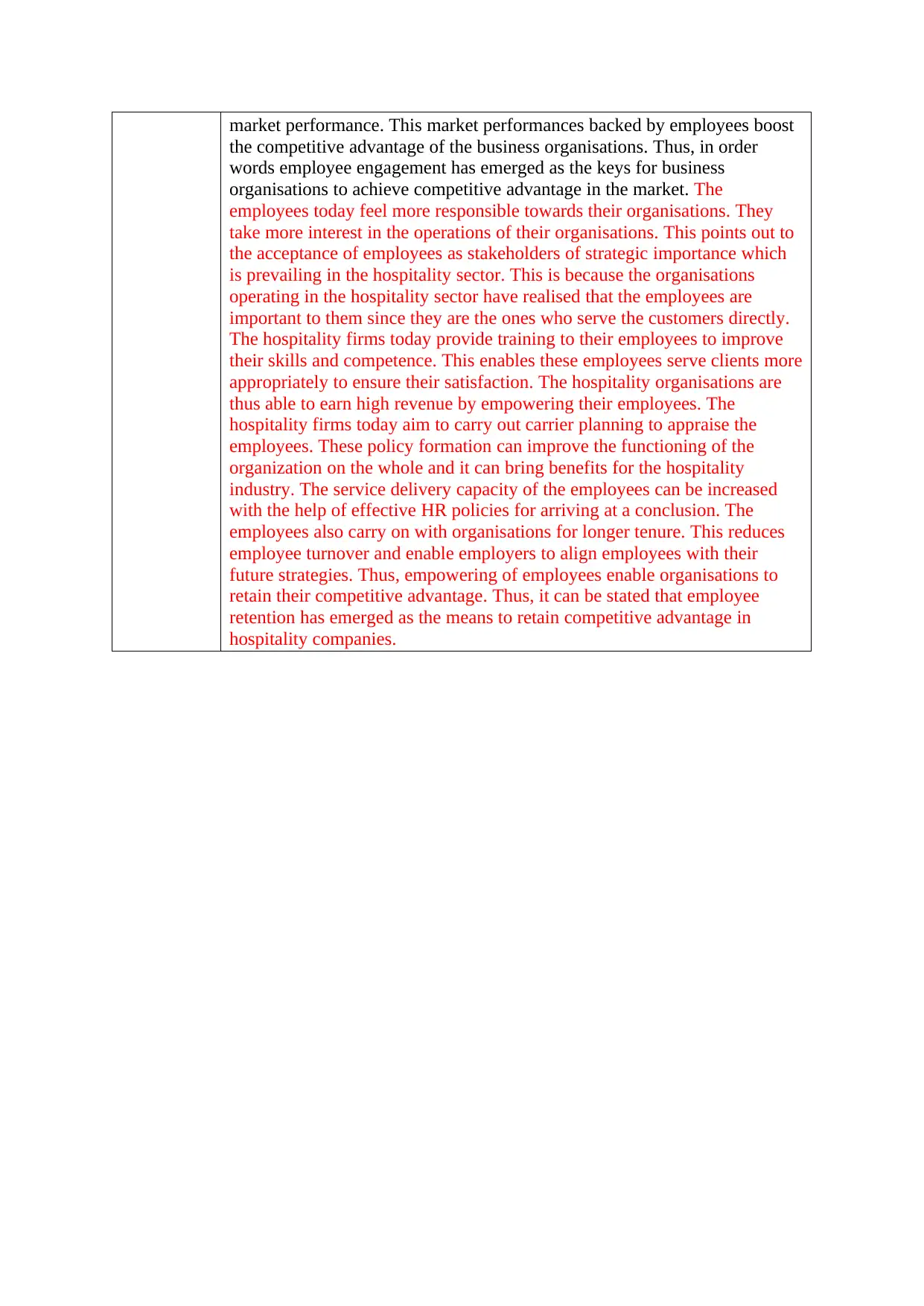
market performance. This market performances backed by employees boost
the competitive advantage of the business organisations. Thus, in order
words employee engagement has emerged as the keys for business
organisations to achieve competitive advantage in the market. The
employees today feel more responsible towards their organisations. They
take more interest in the operations of their organisations. This points out to
the acceptance of employees as stakeholders of strategic importance which
is prevailing in the hospitality sector. This is because the organisations
operating in the hospitality sector have realised that the employees are
important to them since they are the ones who serve the customers directly.
The hospitality firms today provide training to their employees to improve
their skills and competence. This enables these employees serve clients more
appropriately to ensure their satisfaction. The hospitality organisations are
thus able to earn high revenue by empowering their employees. The
hospitality firms today aim to carry out carrier planning to appraise the
employees. These policy formation can improve the functioning of the
organization on the whole and it can bring benefits for the hospitality
industry. The service delivery capacity of the employees can be increased
with the help of effective HR policies for arriving at a conclusion. The
employees also carry on with organisations for longer tenure. This reduces
employee turnover and enable employers to align employees with their
future strategies. Thus, empowering of employees enable organisations to
retain their competitive advantage. Thus, it can be stated that employee
retention has emerged as the means to retain competitive advantage in
hospitality companies.
the competitive advantage of the business organisations. Thus, in order
words employee engagement has emerged as the keys for business
organisations to achieve competitive advantage in the market. The
employees today feel more responsible towards their organisations. They
take more interest in the operations of their organisations. This points out to
the acceptance of employees as stakeholders of strategic importance which
is prevailing in the hospitality sector. This is because the organisations
operating in the hospitality sector have realised that the employees are
important to them since they are the ones who serve the customers directly.
The hospitality firms today provide training to their employees to improve
their skills and competence. This enables these employees serve clients more
appropriately to ensure their satisfaction. The hospitality organisations are
thus able to earn high revenue by empowering their employees. The
hospitality firms today aim to carry out carrier planning to appraise the
employees. These policy formation can improve the functioning of the
organization on the whole and it can bring benefits for the hospitality
industry. The service delivery capacity of the employees can be increased
with the help of effective HR policies for arriving at a conclusion. The
employees also carry on with organisations for longer tenure. This reduces
employee turnover and enable employers to align employees with their
future strategies. Thus, empowering of employees enable organisations to
retain their competitive advantage. Thus, it can be stated that employee
retention has emerged as the means to retain competitive advantage in
hospitality companies.
1 out of 5
Related Documents
Your All-in-One AI-Powered Toolkit for Academic Success.
+13062052269
info@desklib.com
Available 24*7 on WhatsApp / Email
![[object Object]](/_next/static/media/star-bottom.7253800d.svg)
Unlock your academic potential
Copyright © 2020–2025 A2Z Services. All Rights Reserved. Developed and managed by ZUCOL.




